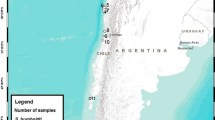Abstract
Some species of avian malaria parasites are invaders and responsible for diversity losses worldwide. Here we analyze the prevalence and genetic characterization of avian malaria and related haemosporidian parasites in Neotropical birds from two different regions of Peru. We detected an overall prevalence of 32.4 % comprising 12 infected bird species. The pathogen Plasmodium relictum SGS1 was widespread and the most prevalent parasite found in our study (39 % of the total infections), infecting 8 host species in both localities. To the best of our knowledge, this is the first report of this invasive pathogen in the mainland Americas, thus representing a possible menace to over one-third of all bird species in the world.


Similar content being viewed by others
References
Atkinson CT, Woods KL, Dusek RJ et al (1995) Wildlife disease and conservation in Hawaii: pathogenicity of avian malaria (Plasmodium relictum) in experimentally infected Iiwi (Vestiaria coccinea). Parasitology 111:S59–S69
Atkinson CT, Dusek RJ, Woods KL et al (2000) Pathogenicity of avian malaria in experimentally-infected Hawaii amakihi. J Wild Dis 36:197–204
Beadell JS, Ishtiaq F, Covas R et al (2006) Global phylogeographic limits of Hawaii’s avian malaria. Proc R Soc Lond B Biol Sci 273:2935–2944. doi:10.1098/rspb.2006.3671
Bensch S, Hellgren O, Pérez-Tris J (2009) MalAvi: a public database of malaria parasites and related haemosporidians in avian hosts based on mitochondrial cytochrome b lineages. Mol Ecol Res 9:1353–1358. doi:10.1111/j.1755-0998.2009.02692.x
Da Silva JMC, Rylands AB, Da Fonseca GAB (2005) The fate of the Amazonian areas of endemism. Conserv Biol 19:689–694. doi:10.1111/j.1523-1739.2005.00705.x
Durrant KL, Beadell JS, Ishtiaq F et al (2006) Avian malaria in South America: a comparison of temperate and tropical zones. Ornithol Monogr 60:98–111
Ewen JG, Bensch S, Blackburn TM et al (2012) Establishment of exotic parasites: the origins and characteristics of an avian malaria community in an isolated island avifauna. Ecol Lett 15:1112–1119. doi:10.1111/j.1461-0248.2012.01833.x
Hall TA (1999) BioEdit: a user-friendly biological sequence alignment editor and analysis program for Windows 95/98/NT. Nucl Acid Symp Ser 41:95–98
Hatcher MJ, Dick JTA, Dunn AM (2012) Disease emergence and invasions. Funct Ecol 26:1275–1287. doi:10.1111/j.1365-2435.2012.02031.x
Hellgren O, Waldenström J, Bensch S (2004) A new PCR assay for simultaneous studies of leucocytozoon, plasmodium and haemoproteus from avian blood. J Parasitol 90:797–802
Hellgren O, Peréz-Tris J, Bensch S (2009) A jack-of-all-trades and still a master of some: prevalence and host range in avian malaria and related blood parasites. Ecology 90:2840–2849. doi:10.1890/08-1059.1
Howe L, Castro IC, Schoener ER et al (2012) Malaria parasites (Plasmodium spp.) infecting introduced, native and endemic New Zealand birds. Parasitol Res 110:913–923. doi:10.1007/s00436-011-2577-z
Jakob EM, Marshall SD, Uetz GW (1996) Estimating fitness: a comparison of body condition indices. Oikos 77:61–67
Lacorte GA, Félix GMF, Pinheiro RRB et al (2013) Exploring the diversity and distribution of neotropical avian malaria parasites—a molecular survey from Southeast Brazil. PLoS One 8(3):e57770. doi:10.1371/journal.pone.0057770
Lapointe DA, Atkinson CT, Samuel MD (2012) Ecology and conservation biology of avian malaria. Ann NY Acad Sci 1249:211–226. doi:10.1111/j.1749-6632.2011.06431.x
Lowe S, Browne M, Boudjelas S et al (2000) 100 of the world’s worst invasive alien species a selection from the global invasive species database. IUCN/SSC Invasive Species Specialist Group (ISSG), Auckland
Marzal A, Ricklefs RE, Valkiūnas G et al (2011) Diversity, loss, and gain of malaria parasites in a globally invasive bird. PLoS One 6(7):e21905. doi:10.1371/journal.pone.0021905
Merino S, Moreno J, Vásquez RA et al (2008) Haematozoa in forest birds from southern Chile: latitudinal gradients in prevalence and parasite lineage richness. Austral Ecol 33:329–340. doi:10.1111/j.1442-9993.2008.01820.x
Palinauskas V, Kosarev V, Shapoval A et al (2007) Comparison of mitochondrial cytochrome b lineages and morphospecies of two avian malaria parasites of the subgenera Haemamoeba and Giovannolaia (Haemosporida: plasmodiidae). Zootaxa 1626:39–50
Schmid-Hempel P (2011) Evolutionary parasitology: the integrated study of infections, immunology, ecology, and genetics. Oxford University Press, Oxford
Schulenberg TS, Stotz DF, Lane DF et al (2010) Birds of Peru, revised and updated. Princeton University Press, Princeton
Tompkins DM, Gleeson DM (2006) Relationship between avian malaria distribution and an exotic invasive mosquito in New Zealand. J Roy Soc New Zeal 36:51–62
Valkiūnas G (2005) Avian malaria parasites and other haemosporidia. CRC Press, Boca Raton
Valkiūnas G, Zickus T, Shapoval AP et al (2006) Effect of Haemoproteus belopolskyi (Haemosporida: haemoproteidae) on body mass of the blackcap Sylvia atricapilla. J Parasitol 92:1123–1125
Van Riper C, van Riper SG, Goff ML et al (1986) The epizootiology and ecological significance of malaria in Hawaiian land birds. Ecol Monogr 56:327–344. doi:10.2307/1942550
Warner RE (1968) The role of introduced diseases in the extinction of the endemic Hawaiian avifauna. Condor 70:101–120
Acknowledgments
We are grateful to many students and researchers for collaboration in collecting samples during avian malaria training workshops in Peru. Two anonymous reviewers provided suggestions to improve the manuscript. This study was funded in part by the US National Science Foundation sponsored Research Coordination Network for Haemosporida of Terrestrial Vertebrates (malariarch.org, NSF 0954891), and the Spanish Ministry of Education and Science (CGL2012-36665). AM and LGL were supported by grants from Spanish Ministry of Education and Science (JC2011-0405 and BES-2010-030295, respectively). Technical and human support provided by Facility of Bioscience Applied Techniques of SAIUEx (financed by UEX, Junta de Extremadura, MICINN, FEDER and FSE). The authors declare that they have no conflict of interest. All the experiments comply with the current laws of Peru, where the experiments were performed.
Author information
Authors and Affiliations
Corresponding author
Rights and permissions
About this article
Cite this article
Marzal, A., García-Longoria, L., Cárdenas Callirgos, J.M. et al. Invasive avian malaria as an emerging parasitic disease in native birds of Peru. Biol Invasions 17, 39–45 (2015). https://doi.org/10.1007/s10530-014-0718-x
Received:
Accepted:
Published:
Issue Date:
DOI: https://doi.org/10.1007/s10530-014-0718-x




